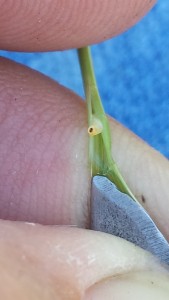Most producers will typically see the resulting damage before finding the pest. Producers are less likely to see damage in a grazing pasture since livestock will keep forage grazed down.
Management recommendations for hay meadow damage are to harvest hay as soon as possible to reduce the yield impact. If damage is found within 1 week of the normal harvest stage, proceed to harvest the crop as soon as weather conditions allow. Once the damage becomes apparent, the crop is unlikely to add a significant amount of yield. If damage is observed within 1 to 3 weeks after a harvest, it is also likely that the crop will not add a significant amount of yield. The damaged crop should be cut and baled and removed from the field as soon as weather conditions allow. Leaving the damaged crop in the field will only compete with any attempts by the plant to regrow and decrease the opportunity that the next cutting will have to accumulate dry matter.
Damage caused by the bermudagrass stem maggot (Photo courtesy of Richard Waligura, Waller County, TX)
A foliar application of any pyrethroid (beta-cyfluthrin, cyfluthrin, lambda-cyhalothrin and zeta cypermethrin) insecticide labeled for bermudagrass can control the bermudagrass stem maggot. However, guidelines on the economic return on controlling this new pest and timing of and frequency of insecticide treatments have not been clearly defined.
Vanessa Corriher-Olson, Forage Extension Specialist, Soil & Crop Sciences, Overton, TX


